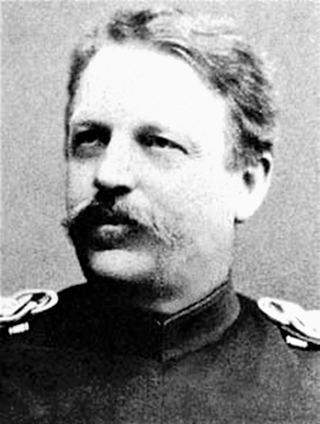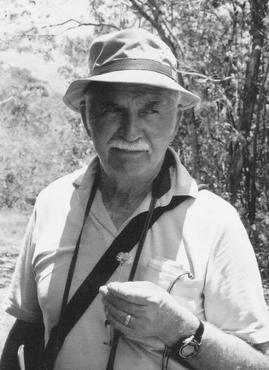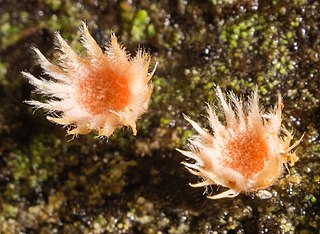
The pied bush chat is a small passerine bird found ranging from West Asia and Central Asia to the Indian subcontinent and Southeast Asia. About sixteen subspecies are recognized through its wide range with many island forms. It is a familiar bird of countryside and open scrub or grassland where it is found perched at the top of short thorn trees or other shrubs, looking out for insect prey. They pick up insects mainly from the ground, and were, like other chats, placed in the thrush family Turdidae, but are now considered as Old World flycatchers.

The Stereaceae are a family of corticioid fungi in the Russulales order. Species in the family have a widespread distribution, are lignicolous or terrestrial, and typically saprobic. According to the Dictionary of the Fungi, the family contains 22 genera and 125 species.

Joseph Schröter was a noted German mycologist and medical doctor. He wrote several books and texts, and discovered and described many species of flora and fungi. He also spent around fifteen years, from 1871 to 1886, as a military doctor, particularly in the Franco-Prussian War, in places such as Spandau, Rastatt and Breslau, and rising to the rank of colonel.

Hubert Bourdot was a French Roman Catholic priest and mycologist who was a native of Imphy, a community in the department of Nièvre.

Curtis Gates Lloyd was an American mycologist known for both his research on the gasteroid and polypore fungi, as well as his controversial views on naming conventions in taxonomy. He had a herbarium with about 60,000 fungal specimens, and described over a thousand new species of fungi. Along with his two brothers John Uri Lloyd and Nelson Ashley Lloyd, he founded the Lloyd Library and Museum in Cincinnati.
Aleurocystis is a genus of fungi in the Stereaceae family. The widely distributed genus contains three species. Aleurocystis was circumscribed by the New Zealand-based mycologist Gordon Herriot Cunningham in 1956.
Gloeohypochnicium is a genus of wood-inhabiting crust fungi of uncertain familial placement in the order Russulales. Originally conceived by Erast Parmasto as a subgenus of Hypochnicium, Kurt Hjortstam considered it worthy of distinct generic status in 1987. The type species, G. analogum, was described as new to science in 1913 by French mycologists Hubert Bourdot and Amédée Galzin as a species of Gloeocystidium. G. versatum was added to the genus in 2010.
Sanford Myron Zeller was an American mycologist.

Robert Joseph Bandoni was a mycologist who specialized on the taxonomy and morphology of the heterobasidiomycetes.

Aleurodiscus grantii is a species of fungus in the family Stereaceae. Found in the Pacific Northwest region of North America and in Japan, it was described as new to science by mycologist Curtis Gates Lloyd in 1920. He remarked "Formed of little convex sporophores with free but not raised margin, growing caespitose on bark. Microscopic characters, as in A. amorphus. This, by those who rely on the microscope, would probably be referred to Aleurodiscus amorphus but the fruiting bodies are entirely different in shape." The specific epithet honors J.M. Grant, who collected the type specimens in Washington state. In 1994, the fungus was reported from Japan.
Viktor Litschauer was an Austrian mycologist.
Aleurodiscus lividocoeruleus is a species of fungus belonging to the family Stereaceae.

Phaeotremella is a genus of fungi in the family Phaeotremellaceae. All Phaeotremella species are parasites of other fungi and produce anamorphic yeast states. Basidiocarps, when produced, are gelatinous and are colloquially classed among the "jelly fungi". Fifteen or so species of Phaeotremella are currently recognized worldwide. Tremella sanguinea, shown to be a Phaeotremella species by DNA sequencing, is cultivated in China as an ingredient in traditional Chinese medicine.

Aleurodiscus oakesii is a cluster of small, gray-white, irregular cup-shaped saprotrophic fungi that grows on decaying hardwood tree bark. This fungus may also be called hophornbeam discs, and it causes smooth patch disease. A. oakesii is found year round in North America, Europe, and Asia and is commonly found on oak trees.

Phaeotremella mycophaga is a species of fungus in the family Phaeotremellaceae. It produces small, pustular, gelatinous basidiocarps on the hymenium of the corticioid fungi Aleurodiscus amorphus and A. grantii on conifers.










